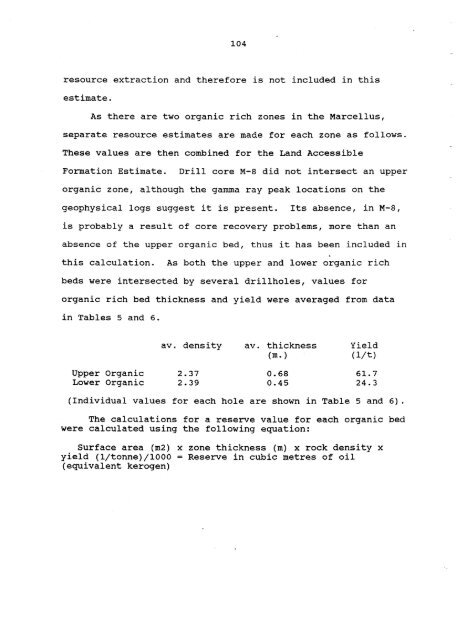stratigraphy and oil shale potential - Geology Ontario
stratigraphy and oil shale potential - Geology Ontario
stratigraphy and oil shale potential - Geology Ontario
Create successful ePaper yourself
Turn your PDF publications into a flip-book with our unique Google optimized e-Paper software.
104<br />
resource extraction <strong>and</strong> therefore is not included in this<br />
estimate.<br />
As there are two organic rich zones in the Marcellus,<br />
separate resource estimates are made for each zone as follows.<br />
These values are then combined for the L<strong>and</strong> Accessible<br />
Formation Estimate. Drill core M-8 did not intersect an upper<br />
organic zone, although the gamma ray peak locations on the<br />
geophysical logs suggest it is present. Its absence, in M-8,<br />
is probably a result of core recovery problems, more than an<br />
absence of the upper organic bed, thus it has been included in<br />
this calculation. As both the upper <strong>and</strong> lower organic rich<br />
beds were intersected by several drillholes, values for<br />
organic rich bed thickness <strong>and</strong> yield were averaged from data<br />
in Tables 5 <strong>and</strong> 6.<br />
av. density av. thickness Yield<br />
(m.) (1/t)<br />
Upper Organic 2.37 0.68 61.7<br />
Lower Organic 2.39 0.45 24.3<br />
(Individual values for each hole are shown in Table 5 <strong>and</strong> 6).<br />
The calculations for a reserve value for each organic bed<br />
were calculated using the following equation:<br />
Surface area (m2) x zone thickness (m) x rock density x<br />
yield (I/tonne)/1000 = Reserve in cubic metres of <strong>oil</strong><br />
(equivalent kerogen)

















